Select Language

(Reuters) - New York-based stock exchange Nasdaq Inc agreed to pay a $4 million settlement to the U.S. Department of Treasury over apparent violations of sanctions against Iran by a former Nasdaq unit, the department's Office of Foreign Assets Control (OFAC) said on Friday.
Nasdaq OMX Armenia provided services to Iran and Iran's state-owned Bank Mellat, it said.
"The settlement amount reflects OFAC's determination that Nasdaq's conduct was non-egregious and voluntarily self-disclosed," OFAC said.
Nasdaq said in an emailed statement that the settlement acknowledged mitigating factors, including Nasdaq's voluntary disclosure of the transactions in 2014 and its sale of the Armenian subsidiary in 2018.
Nasdaq acquired the Armenian Stock Exchange, subsequently renamed Nasdaq OMX Armenia, when it acquired Swedish financial company OMX AB in February 2008.

By Steven Scheer
JERUSALEM (Reuters) -Israel registered a budget deficit of 16.6 billion shekels ($4.5 billion) in November, the Finance Ministry said on Sunday, citing a jump in expenses to fund Israel's war with Hamas militants in the Gaza Strip.
As a percentage of GDP, the deficit over the previous 12 months rose to 3.4% in November - 62.3 billion shekels - from 2.6% in October, it said.
A ministry source said the deficit for 2023 would finish at about 4% of GDP, above a target of 0.9%, or 16.9 billion shekels, in the budget approved by lawmakers in May.
The ministry noted that revenue fell by 15.6% last month, partly because of tax deferments resulting from the war that began on Oct. 7.
November revenue was 30.3 billion shekels, the lowest monthly level this year. For the first 11 months of the year, revenue reached 401.5 billion shekels, 6.2% lower than the same period last year.
Overall, the war is expected to weigh on growth in 2023 and 2024. The ministry and central bank project growth of 2% this year and 1.6% and 2% respectively in 2024.
Expenses reached nearly 47 billion shekels, with about 6 billion attributable to the war, helping to push up January-November spending by 11.5% to 445.3 billion shekels.
Israel's deficit in October was 22.9 billion shekels and in November 2022 it was 1.7 billion shekels.
Last week parliament gave its initial nod to a war budget that would add more than 30 billion shekels to spending on the war for the rest of 2023. The plan still requires final approval.
($1 = 3.7033 shekels)

BEIJING (Reuters) -China's consumer prices fell the fastest in three years in November while factory-gate deflation deepened, indicating rising deflationary pressures as weak domestic demand casts doubt over the economic recovery.
The consumer price index (CPI) dropped 0.5% both from a year earlier and compared with October, data from the National Bureau of Statistics (NBS) showed on Saturday.
That was deeper than the median forecasts in a Reuters poll of 0.1% declines both year-on-year and month-on-month. The year-on-year CPI decline was the steepest since November 2020.
The numbers add to recent mixed trade data and manufacturing surveys that have kept alive calls for further policy support to shore up growth.
Xu Tianchen, senior economist at the Economist Intelligence Unit, said the data would be alarming for policymakers and cited three main factors behind it: falling global energy prices, the fading of the winter travel boom and a chronic supply glut.
"Downward pressure will continue to rise in 2024 as developers and local governments continue to deleverage and as global growth is expected to slow," Xu said.
Year-on-year core inflation, excluding food and fuel prices, was 0.6%, the same as October.
Bruce Pang, chief economist at Jones Lang Lasalle (NYSE:JLL), said the weak core CPI reading was a warning about persistently sluggish demand, which should be a policy priority for China if it is to deliver more sustainable and balanced growth.
Although consumer prices in the world's second-biggest economy have been teetering on the edge of deflation in recent months, China's central bank Governor Pan Gongsheng said last week inflation was expected to be "going upwards".
The producer price index (PPI) fell 3.0% year-on-year against a 2.6% drop in October, marking the 14th straight month of decline and the quickest since August. Economists had predicted a 2.8% fall in November.
China's economy has grappled with multiple headwinds this year, including mounting local government debt, an ailing housing market and tepid demand at home and abroad. Chinese consumers especially have been tightening their purse strings, wary of uncertainties in the elusive economic recovery.
Moody's (NYSE:MCO) on Tuesday issued a downgrade warning on China's credit rating, saying costs to bail out local governments and state firms and to control the property crisis would weigh on the economy.
China's finance ministry called the decision disappointing, saying the economy would rebound and risks were controllable.
The authorities will spur domestic demand and enhance economic recovery in 2024, the Politburo, a top decision-making body of the ruling Communist Party, was quoted by state media as saying on Friday.
Markets are awaiting more government stimulus at the annual agenda-setting "Central Economic Work Conference" later this month.
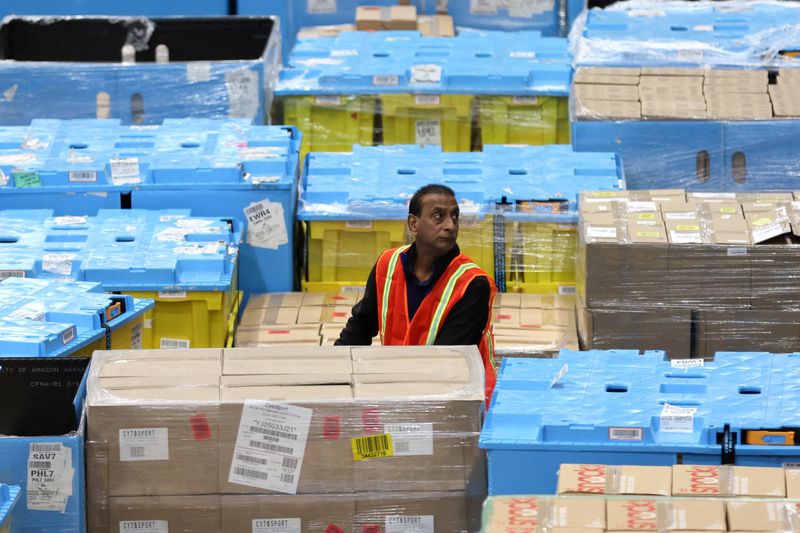
By Lucia Mutikani
WASHINGTON (Reuters) - U.S. job growth likely picked up in November as thousands of automobile workers and actors returned after strikes, but the underlying trend will probably point to a cooling labor market.
The Labor Department's closely watched employment report on Friday, which is also expected to show wages increasing moderately and the unemployment rate unchanged at nearly a two-year high of 3.9%, will cement views that the Federal Reserve is done raising interest rates this cycle.
But with employment gains forecast to remain well above the 100,000 jobs per month needed to keep up with growth in the working age population, it could pour cold water on financial market expectations of the U.S. central bank pivoting to cutting rates as soon as the first quarter of 2024.
The Fed is expected to keep rates unchanged next Wednesday. It has raised its policy rate by 525 basis points to the current 5.25%-5.50% range, since March 2022.
"We're looking for more evidence that restrictive monetary policy and tight credit conditions are having the desired effect, dampening inflationary pressures, not only in the economy more broadly, but also the labor market," said James Knightley, chief international economist at ING in New York.
"I don't think the Fed will be signaling a desire to cut on the scale that the market is looking to price right now, but they will be pretty happy with the evidence of the cooling jobs market."
Nonfarm payrolls likely increased by 180,000 jobs last month after rising 150,000 in October, according to a Reuters survey of economists. About 25,300 members of the United Auto Workers (UAW) union ended their strikes against Detroit's "Big Three" car makers on Oct. 31, which depressed manufacturing payrolls that month, government data showed.
At least 5,000 UAW members remain on strike, the majority of them at Mack Trucks. Payrolls also likely got a lift from 16,000 members of the SAG-AFTRA actors union going back to work.
Still, employment gains would be less than the monthly average of 238,800 jobs this year. Demand for workers is moderating as the hefty rate hikes from the Fed curb demand in the broader economy. The government reported this week that there were 1.34 job openings for every unemployed person in October, the lowest since August 2021.
There has also been anecdotal evidence of slowing hiring, with the Fed's Beige Book report last week describing demand for labor as having "continued to ease" and "most districts reported flat to modest increases in overall employment" from early October through mid-November.
Temporary help, a harbinger of future hiring, has declined for much of this year. The average workweek has also dropped from 34.6 hours in January to 34.3 hours in October. It is expected to have been unchanged at that level in November.
RISING LABOR POOL
But not every economist agrees that the labor market is softening, arguing that significant portions of the economy, especially in the service sector, remain understaffed.
Indeed, an Institute for Supply Management survey this week showed services industry businesses in November reporting "issues" backfilling vacancies caused by normal attrition. There were also comments that "the labor market remains very competitive" and about "trying to get to full staff levels."
"We're not convinced that the labor market has really slowed abruptly here," said Dean Maki, chief economist at Point72 Asset Management in Stamford, Connecticut. "The underlying trend in job growth remains pretty healthy."
The unemployment rate has risen from a 53-year low of 3.4% in April. The increase, however, has been driven by a rise in labor supply rather than companies laying off workers. Economists said there was a risk that the jobless rate could hit 4.0% in November, but urged against interpreting the rise as a sign of deteriorating labor market conditions.
"More people are coming into the labor force, and they're counted as unemployed when they come in," said Dan North, senior economist at Allianz (ETR:ALVG) Trade North America. "It's not companies firing people. So, it's not the usual dynamic that would make one concerned."
The expanding labor pool is slowing wage growth, boosting the Fed's efforts to lower inflation to its 2% target.
Average hourly earnings are forecast climbing 0.3% after gaining 0.2% in October. That would lower the annual increase in wages to 4.0%, which would the smallest advance since June 2021, after rising 4.1% in October.
Moderate wage gains would add to recent data showing inflation ebbing in October.
While that could contribute to crimping consumer spending this quarter and beyond, economists do not expect a recession, but rather a period of tepid growth. Most did not see the economy shedding jobs until the second quarter of 2024.
"We may have some quarters of virtually flat growth, overall, very very slow growth for the whole year," said North.

A look at the day ahead in European and global markets from Tom Westbrook
Nine of the G10 central banks are expected to cut interest rates next year. Not Japan.
Bank of Japan Governor Kazuo Ueda's open discussion of a difficult policy year ahead and of possible paths out of negative interest rates has jolted short sellers out of the yen, afraid that the long-awaited yen rally may have begun.
The yen is up four weeks in a row for the first time since March. It steadied in Tokyo trade on Friday, perhaps since data showed the economy slowed more sharply than first thought in the third quarter, which makes the next policy steps more complicated.
Japanese government bonds have been heavily sold, tugging global yields higher. The Nikkei dropped to a one-month low.
The consequences of above-zero rates in Japan, and particularly the possibility the BOJ will be hiking while the rest of the world is cutting, could be huge since it may trigger an unwinding of carry trades and a rearrangement of the flow of Japanese capital.
The BOJ next meets on Dec. 19. Before then the ECB, Bank of England and Fed will all meet, with markets expecting rates to stay on hold. U.S. non-farm payrolls figures due later on Friday round out the week and will set the tone for the policymakers.
An upside surprise in the jobs numbers would probably generate the most turbulence in markets, since a handful of recent indicators - pointing to a cooling labour market and slowing inflation - were behind a powerful bond rally in anticipation of rate cuts.
The European calendar is fairly bare on Friday.
Elsewhere in Asia, India's central bank kept its key lending rate on hold, as expected. South Korea's National Pension Service and central bank are in talks to extend their foreign exchange swap programme, sources with direct knowledge of the matter told Reuters, and the won rose sharply.
Shares in Australian gas producer Santos rose 6% and Woodside (OTC:WOPEY) stock fell 0.5% after the companies confirmed speculation they were in preliminary merger talks.
Key developments that could influence markets on Friday:
Economics: Final German CPI, U.S. non-farm payrolls
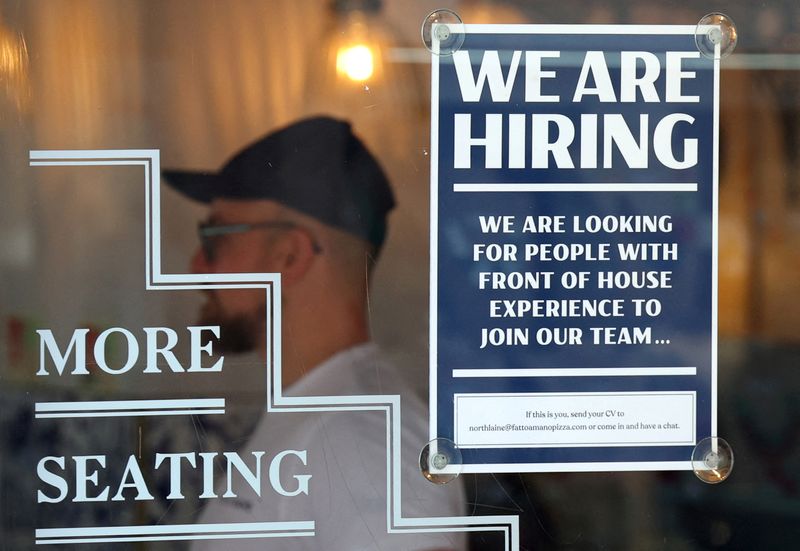
By David Milliken
LONDON (Reuters) - Starting salaries for newly appointed employees in Britain rose at the slowest pace since March 2021 last month, according to industry data that offered some comfort to the Bank of England in its fight against inflation pressures.
The Recruitment and Employment Confederation monthly survey has pointed towards a cooling in Britain's hot hiring market for much of this year although it has been slow to translate into broader official labour force data.
The BoE is keeping a close watch on labour market trends as it fears shortages of workers and skills mismatches since Brexit and the COVID-19 pandemic will make it hard to return inflation - currently 4.6% - to its 2% target.
The BoE is expected to keep interest rates at a 15-year high next week and restate that it is not close to cutting them.
Official data showed average pay excluding bonuses grew at an annual rate of 7.7% in the third quarter of 2023, only just off a previous record high.
By contrast, the REC survey showed a marked slowdown in the growth of starting salaries and pay rates for temporary staff in November. The latter increased at the weakest pace since February 2021.
"Businesses want to plan for the year ahead, but the prospect of faltering UK economic growth means the certainty they need isn't there. This is now impacting starting salaries," said Claire Warnes, a partner at KPMG which sponsors the survey.
The BoE predicts Britain's economy will record zero growth in 2024 and other forecasting bodies are not much more optimistic.
REC said job vacancies fell last month for only the second time since February 2021 while the number of job seekers rose by the most since December 2020. Recruiters were "widely linking this to redundancies and workers concerned about their current job security", it added.
The survey was based on responses from 400 recruitment agencies collected from Nov. 9 to Nov. 24.

By Noel Randewich and Shristi Achar A
(Reuters) - The Nasdaq ended sharply higher on Thursday after Alphabet (NASDAQ:GOOGL) and Advanced Micro Devices (NASDAQ:AMD) sparked a megacap rally on fresh optimism about artificial intelligence.
Shares of Alphabet jumped 5.3% as analysts cheered the launch of the Google-parent's newest AI model, while AMD soared nearly 10% after the company estimated the potential market for its data center AI chips could reach $45 billion this year.
Other heavyweight tech-related stocks also gained, with Nvidia (NASDAQ:NVDA) and Meta Platforms (NASDAQ:META) rising over 2%, Amazon (NASDAQ:AMZN) up 1.6% and Apple (NASDAQ:AAPL) 1% higher.
The Philadelphia semiconductor index jumped 2.8%, increasing its 2023 gain to 48%, much of that fueled by bets about the future of AI.
"Today it's an AMD-Google rally. There's a contagion effect across the market. Everyone wants to get on the bandwagon," said Jay Hatfield, CEO of Infrastructure Capital Management in New York.
"We're kind of in this weird market, a tag-team market, where one day tech leads, and then the next day value and the broad market lead."
The S&P 500 has steadily climbed since the end of October on expectations the Federal Reserve has finished its campaign of interest rate hikes and that it could begin cutting rates in March.
The S&P 500 climbed 0.80% to end the session at 4,585.59 points, with 1.8 stocks in the index gaining for each one that fell.
The most traded stock in the S&P 500 was Tesla (NASDAQ:TSLA), with $25.7 billion worth of shares changing hands during the session. The shares rose 1.37%.
The Nasdaq Composite jumped 1.37% to 14,339.99 points, while Dow Jones Industrial Average rose 0.18% to 36,117.57 points.
Volume on U.S. exchanges was relatively heavy, with 11.2 billion shares traded, compared to an average of 10.8 billion shares over the previous 20 sessions.
Traders have almost fully priced in the likelihood of the Fed keeping rates unchanged at its meeting next week.
Data on Thursday showed the number of Americans filing new claims for unemployment benefits increased less than expected last week to a seasonally adjusted 220,000 for the week.
A Labor Department jobs report due on Friday could hint at how quickly the U.S. economy is softening and may sway expectations about when the Fed is likely to begin cutting rates. Non-farm payrolls are expected to have increased by 180,000 jobs last month after rising by 150,000 in October.
Interest rate futures imply a nearly 64% chance of a rate cut as soon as March, according to the CME Group's (NASDAQ:CME) FedWatch tool.
Limiting gains in the Dow, shares of Merck fell 1.7% after the drugmaker's immunotherapy combination failed in a lung cancer study.
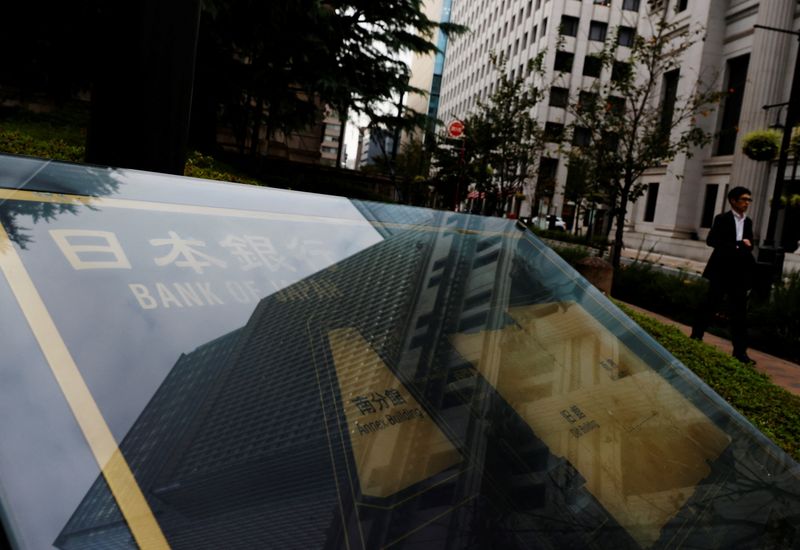
TOKYO (Reuters) - Japan's economy contracted at an annualised clip of 2.9% in July-September from the previous quarter, worse than the initial estimate of a 2.1% drop, government data showed on Friday.
The revised figure for gross domestic product (GDP) released by the Cabinet Office compared with economists' median forecast for a 2.0% decline in a Reuters poll.
On a quarter-on-quarter basis, GDP shrank 0.7%, compared with the initial 0.5% drop reading and a median forecast for a 0.5% fall.
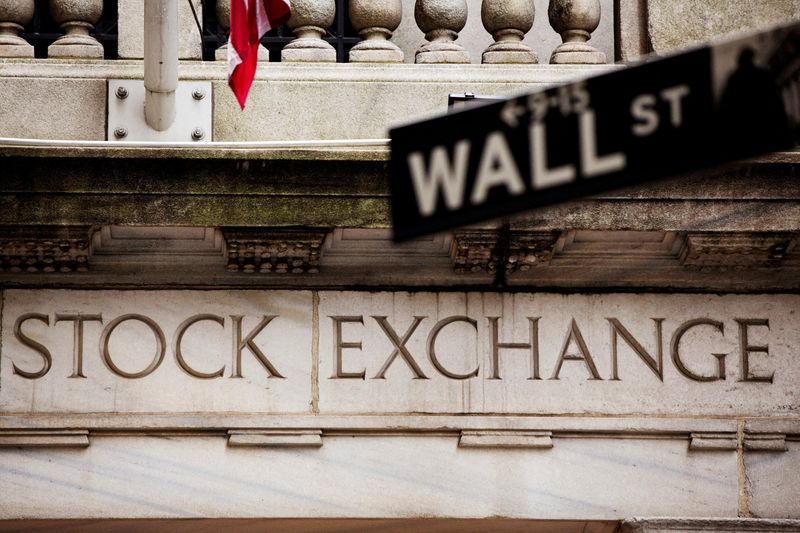
By Naomi Rovnick
LONDON (Reuters) - Investment banks and asset managers have wildly varying stock market and currency calls for 2024, reflecting deep division over whether the U.S. economy will enter a long-heralded recession and drag the world with it.
The lack of consensus among forecasters is a stark contrast to a year ago, when most predicted a U.S. recession and rapid rate cuts that failed to materialise. The world's largest economy expanded by 5.2% in the third quarter of this year.
The divisions this year have produced a scattergram of projections for the U.S. interest rate path and how global assets that are influenced by the Federal Reserve's actions will perform.
Market participants are therefore bracing for a bumpy start to the new year after a strong rally last month for both stocks and bonds based on a short-term consensus that inflation and interest rates are on a firm downward path.
"Whether the U.S. has a hard landing or a soft landing will dominate the market," said Sonja Laud, chief investment officer at Legal & General Investment Management.
"The narrative isn't clear yet," she added, noting that if current interest rate forecasts "were to shift significantly that creates significant volatility".
Options trading data shows that investors are becoming increasingly interested in protecting their portfolios from heightened stock market volatility ahead.
ALL TOGETHER...NOT
Economists polled by Reuters predict 1.2% U.S. GDP growth for 2024 on average.
But while forecasters are united that the Fed's most aggressive rate hiking cycle in decades will cause a slowdown, they are split on whether 2024 will also include a couple of quarters of economic contraction that may prompt rate cuts and weaken the dollar.
Amundi, Europe's largest asset manager, now expects a U.S. recession in the first half of 2024, meaning the group is negative on the dollar and likes emerging market assets.
In foreign exchange, Japan's yen will be the market's "bright spot" as the Bank of Japan is expected to finally move away from its ultra-easy monetary policy, said Amundi CIO Vincent Mortier.
The yen is trading around 147 per dollar, not too far from 30-year lows.
Morgan Stanley, however, sees no recession and reckons the Fed may keep rates high well into next year. It views the dollar index rising to 111 points from 104 currently, the euro dropping to $1 and the yen recovering only moderately to 142 per dollar.
STOCKS, UP OR DOWN?
For U.S. stocks, which drive world equity markets, forecasters are divided between what Citi head of trading strategy Stuart Kaiser calls the "converts and disciples" of last year's strong recession consensus.
"Some bears are (still) very dedicated and believe that if it didn't happen this year it has to happen next year," Kaiser said.
Deutsche Bank predicts a mild U.S. recession in the first half of 2024 and a whopping 175 basis points of rate cuts, with lower borrowing costs driving the S&P 500 share index to 5,100 points. The S&P 500 has gained 19% this year to 4,567.
JP Morgan views a recession as possible and the S&P finishing the year at 4,200, while Goldman Sachs sees only limited recession risk.
Equity analysts' estimates of S&P 500 earnings are currently the most dispersed since the COVID-19 pandemic, according to Blackrock (NYSE:BLK) Investment Institute (BII).
LGIM, which manages roughly $1.5 trillion of assets, is underweight equities and expects a U.S. downturn, Laud said.
Some investors meanwhile had moved beyond the U.S. economy debate to seek other opportunities.
Luca Paolini, chief strategist at Pictet Asset Management, said the firm's big call was for gains in European equities, which they believed were undervalued.
BONDS ARE BACK
Most economic forecasters agree that a global inflation surge is over. But whether this means dramatic rate cuts, which generally raise bond prices as yields fall, is not something investors agree on either.
Bond giant PIMCO puts the probability of a U.S. recession in 2024 at 50% and recommends government debt over equities.
HSBC fixed income strategists target a 3% yield for the benchmark 10-year U.S. Treasury by late 2024, down from about 4.3% currently.
But Adrian Gray, global chief investment officer at Insight Investment Management, said government bond markets had moved too exuberantly already.
"We're seeing the Fed, the European Central Bank and the Bank of England all cutting (rates) from around Q3 next year," he said.
"Right now, government bond markets are pricing in more than that," he said, projecting yields would rise "a little," from here.
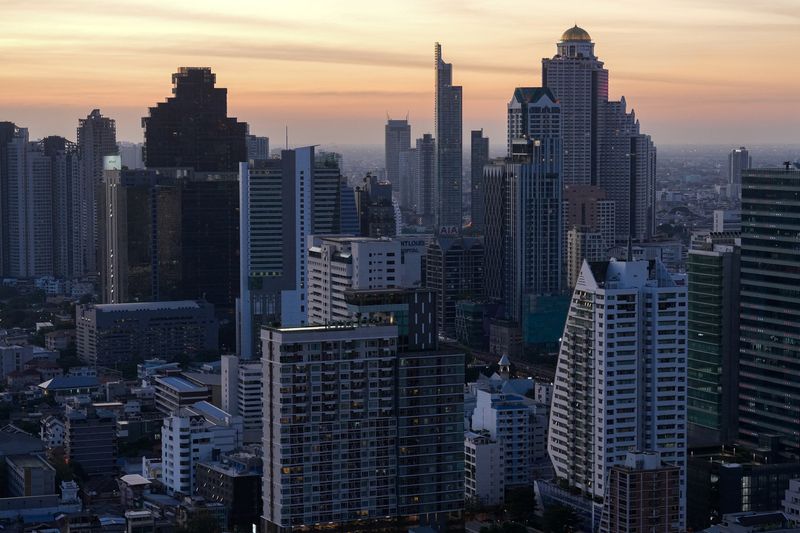
BANGKOK (Reuters) - Thailand's headline consumer price index (CPI) came in at -0.44% in November from a year earlier, the second consecutive month and lowest in nearly three years, the commerce ministry said on Thursday.
The figure compared with a 0.31% year-on-year drop in the previous month and against a forecast for -0.30% inflation in November in a Reuters poll.
Government energy policies have lowered prices for diesel, while pork and chicken meat prices also declined, the ministry said.
It was the seventh successive monthly headline inflation that was below the central bank's target range of 1% to 3%.
Core CPI was at 0.58% year-on-year in November, versus a forecast of 0.60%.
In the January-November period, the headline CPI rose an average 1.41% year-on-year, with the core CPI up 1.33%.
Headline inflation next year is seen in the range of -0.3% to 1.7%, due to measures to reduce costs of living, head of the ministry's trade policy and strategy office Poonpong Naiyanapakorn, told reporters.
"There won't be deflation because prices came down due to government measures, but product prices and the economy continued to grow," he said.

